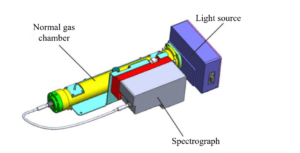UV-GAS-100M Ultraviolet(UV) sensor is an independently self-developed flue gas analysis product which is suitable for online gas analysis of environmental protection and industrial control sites. Based on Ultraviolet Absorption Spectroscopy and Differential Optical Absorption Spectroscopy, it adopts optical technology platform, and can conduct online analysis and measurement for gases including SO2, NO, NO2, H2S, Cl2 and NH3, etc. Under normal conditions, it is used to measure gas component of SO2, NOX and other gas components can be extended. One module can simultaneously carry out measurement for 5 gas components at maximum. The product owns features of high measurement accuracy and reliability, fast response and wide application.
| Product Model | UV-GAS-100M(measure SO2,NO,NO2,CL2,H2S) | |
| Measuring Principle | UV-DOAS | |
| Technical Index | Linearity error | ≤ ±2%FS |
| Repeatability | ≤ 0.5% | |
| Stability | ≤ 2% | |
| Zero drift | ≤ ±2%FS | |
| Span drift | ≤ ±2%FS | |
| Response time | < 25s | |
| Weight | 3.2kg | |
| Dimension | 420mm*160mm*80mm | |

ESEGAS Ultraviolet(UV) sensor is a type of gas sensor that utilizes ultraviolet (UV) light to measure the concentration of specific gases in a gas sample. It employs the UV-DOAS (Ultraviolet Differential Optical Absorption Spectroscopy) principles to analyze the gas composition.
Here are the components of a UV-DOAS gas sensor:
UV-DOAS gas sensors are commonly used for the detection and measurement of gases such as nitrogen dioxide (NO2), sulfur dioxide (SO2), ozone (O3), and volatile organic compounds (VOCs). They find applications in environmental monitoring, industrial processes, air quality assessment, and emission control. These sensors offer accurate and reliable gas concentration measurements, helping to ensure safety, compliance, and environmental protection in various settings.
Measuring carbon dioxide (CO2) is important for understanding the role it plays in the environment and its effect on climate change. CO2 is a major component of Earth’s atmosphere, and it traps heat like a blanket, causing global temperatures to rise. Too m uch CO2 can lead to drastic changes in our weather patterns and ecosystems, so monitoring its levels is essential for predicting future climate conditions. Additionally, measuring CO2 can help us better understand our impact on the environment and make informed decisions about how to reduce emissions and slow down down down down down global warming. By analyzing CO2 data over time, we can develop strategies to mitigate the effects of climate change and ensure a sustainable future.
Before industrialization, the global average annual atmospheric carbon dioxide concentration was 278ppm (1ppm is one part per million). In 2012, the global annual average atmospheric carbon dioxide concentration was 393.1ppm. By April 2014 , the monthly average carbon dioxide concentration in the northern hemisphere atmosphere exceeded 400ppm for the first time. . 2. Global climate warming, the continuous aggravation of the atmospheric greenhouse effect leads to global climate warming, resulting in a series of global climate problems that cannot be predicted by today’s science. According to the International Climate Change Economics Report, if human beings maintain the current way of life, by 2100, there will be a 50% chance that the global average temperature will rise by 4°C.
Copyright © 2023 esegas.com, All rights reserved.


Enviro Solutions Technology Co., Ltd (ESE Technology) is a gas analyzer manufacturer and leading provider in ODM/OEM services for gas analysis systems used by international famous brands.
We will contact you within 1 working day, please pay attention to the email with the suffix “[email protected]” .
We’ll send you the catalog as soon as you submit your email